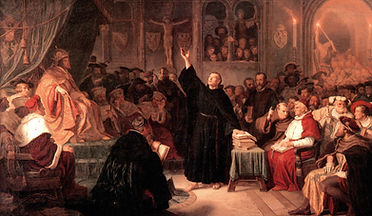
Religion in England
Henry VIII's move to break from the Catholic Church shook England to its very core. 100% of England, Scotland, and Wales were officially Catholic. They viewed the Pope as God's mouthpiece. The idea that the King of England would defy the Pope was unheard of. Henry VIII redefined himself as God's presence in England, taking the place of the Pope.

A thousand years of Catholicism
Catholicism arrived in Britain as early as the 1st century AD, but didn't become popular until 597 AD when Pope Gregory the Great set St. Augustine to firmly establish Catholicism in England. His mission created a strong alliance between the papcy and the crown which lasted until Henry VIII decided he wanted to divorce his wife.

Religion had an impact on every single aspect of every member of the population's lives. The people of England, peasants and royals alike, started and ended their day with prayer. The Catholic Church even limited the days of the year when couples were permitted to have sex (don't you dare get it on on a holy day of obligation!) . The Church ultimately had more power than the crown.
In addition to their devoted following of the Catholic Church, the people of Tudor era England were extremely superstitious. They looked for signs everywhere. A rainy wedding day meant a bad marriage. Seeing a black dog meant your death was imminent, and many of the superstitions that permeate our society today got their start in Tudor England: walking under a ladder, a black cat crossing your path, and spilling salt were all thought to bring bad luck. It's not far fetched that Henry VIII would genuinely believe that his marriage to his brother's wife was cursed.
The reformation
After his break from the Church, Henry actually made very few religious changes. It was his son, Edward VI, who made major Protestant reforms including changing church rituals and eliminating many Catholic practices. After Edward died, his Catholic sister Mary briefly restored Catholicism and persecuted Protestants, but when Elizabeth I became queen, she returned England to Protestantism.

Over time, Protestantism became deeply connected to English identity. Younger generations only knew Protestant practices. Elizabeth I maintained a moderate approach to religion that kept most people happy except the extreme Protestants (Puritans). Eventually, Catholicism was mostly eliminated from England, and Protestantism became firmly established as the nation's religion. This also led to an increase in literacy because Protestants emphasized the importance of having a personal relationship with the word of God (the Bible).
Puritanism
The roots of Puritanism are to be found in the beginnings of the English Reformation. It was the most radical form of Protestantism which sought to "purify" the church by removing practices they considered Roman Catholic.

Puritans felt that they had a direct covenant with God to enact these reforms, but they didn't have the support of either the Catholic Church or the crown. Many Puritans migrated to Northern English colonies in the 1620s and 1630s, laying the foundation for the religious, intellectual and social order of New England. Aspects of Puritanism have reverberated throughout American life ever since, including the Puritan ideal of a Christian American utopia with an authoritarian government. Evangelicals were heavily influenced by Puritan ideals.